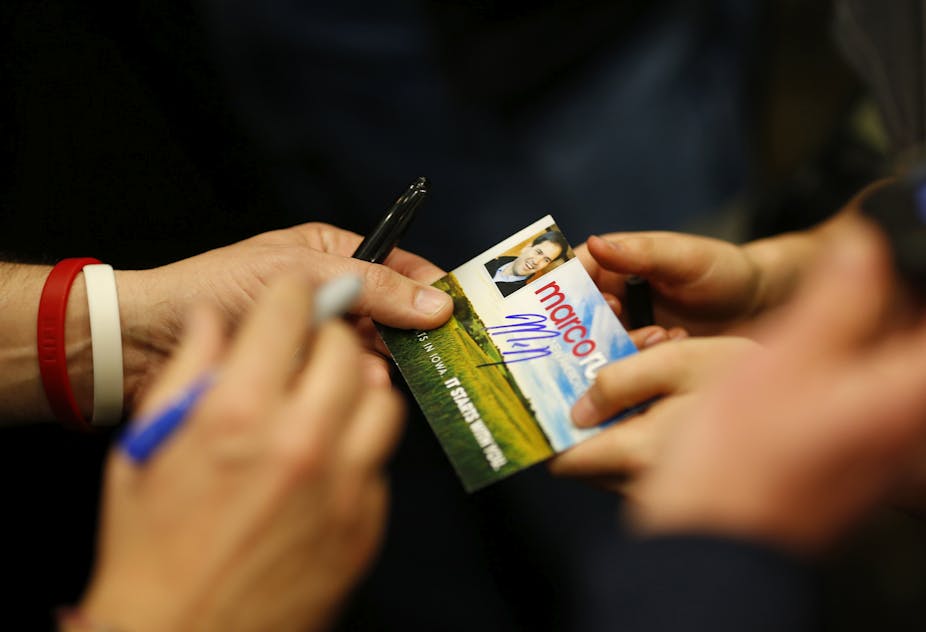Heading into the Iowa caucuses, all the main forecasting methodologies ranked Donald Trump and Hillary Clinton as favourites to win the first contests in their respective nomination battles. In the end, they were half right, if only just): while Clinton managed to squeak the narrowest of wins over Bernie Sanders, Trump came second behind Ted Cruz of Texas, with Florida’s Marco Rubio nipping at his heels.
The results were written up with varying degrees of surprise and shock. So who did the best job of predicting them?
Of the opinion polls, the Des Moines Register/Bloomberg Politics survey is generally regarded as the gold standard in terms of the Iowa state caucuses. In its last survey before voting began, it had Trump on the Republican side leading Ted Cruz by 28% to 23%, with Marco Rubio on 15%. For the Democrats, Clinton was leading Sanders by 45% to 42%. This survey proved wide of the mark and, in that regard, it was broadly consistent with other recent polling.
Then there’s the panel-of-experts model. One such group is the Politico Caucus, a panel of strategists, operatives and activists. In its final survey, Republicans were split, but put Donald Trump in pole position, with Cruz second and Rubio third. Democratic insiders were less divided, coming out strongly in favour of a decisive Clinton victory. So, also wrong.
But there’s another way of forecasting that often proves to be much closer to the actual result: the betting and prediction markets. These can be observed in real time through the Oddschecker service (which lists a range of leading bookmaker prices) as well as by observing the prices on the person-to-person betting exchanges.
There are also dedicated “crowd wisdom” prediction markets such as Almanis, “wisdom of crowd” projects such as Predictwise, as well as real-money prediction markets such as PredictIt and the Iowa Electronic Markets.
On the eve of the caucuses, the real-money betting and prediction markets gave Clinton about a two-in-three chance of winning Iowa, and Trump just a little less. Rubio, it seemed, was trailing third by a fair margin. In the event, it was Cruz who surged to victory among the Republicans while Rubio’s third-place showing was unexpectedly strong. The Democratic race was labelled pretty much across the board as too close to call for most of the count, but the betting markets sided consistently with Clinton.
As soon as the actual results are declared, the betting markets adjust to incorporate the new information. So far they’ve already shaken up their thinking about who will become the Republican party’s nominee, but have barely flickered in regard to the Democratic choice.
Odds on
Going into the caucuses, of the main candidates the betting markets gave Trump a 50% chance of winning the Republican nomination, followed by Rubio on 32%, Cruz on 9% and Jeb Bush on 8%. The commensurate predictions for the Democratic nomination were 80% for Clinton and 19% for Sanders.

In terms of winning the White House, Clinton was firm favourite, with a 51% chance of winning the general election, followed by Trump on 19%, Rubio on 15%, Sanders on 6%, Cruz on 4% and Bush on 3%.
As Americans woke up after the count that map had changed significantly, at least on the Republican side. The new favourite to win the Republican nomination on the betting markets is Rubio, who emerged from the polling with a 53% chance of being the eventual nominee, followed by Trump on 26%, Cruz on 14% and Bush on 5%.
Despite the narrowness of the Democratic contest, the betting markets were unfazed, with Clinton clinging to her 80% chance of taking the nomination.
As to the map of probabilities for who will eventually win the White House, the markets still rank Clinton as the firm favourite for the presidency, just as strong as before Iowa, and Rubio is now her closest challenger: the markets now rate his chances of progressing all the way to victory in November at more than one in five, up from 15%. Trump’s chance has slipped to about one in ten, down from 19%.
So the news of the night is that nothing has really changed on the Democratic front, while Rubio has leapfrogged Trump as the most likely challenger to Clinton. Next comes the New Hampshire primary – and the outcome of that might turn out to be much more significant.

